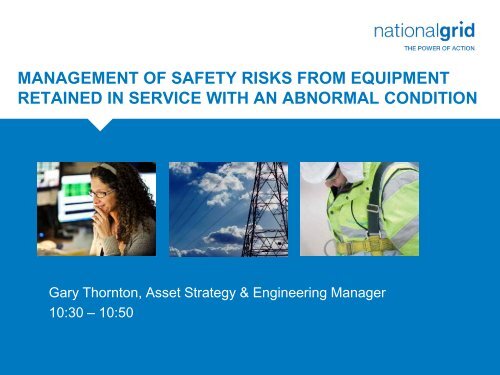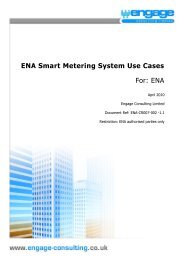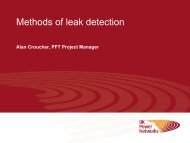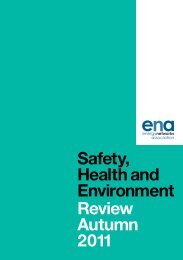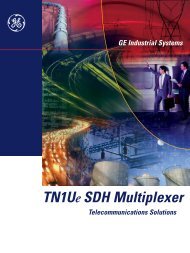FMJL Current Transformer Failures - Energy Networks Association
FMJL Current Transformer Failures - Energy Networks Association
FMJL Current Transformer Failures - Energy Networks Association
You also want an ePaper? Increase the reach of your titles
YUMPU automatically turns print PDFs into web optimized ePapers that Google loves.
MANAGEMENT OF SAFETY RISKS FROM EQUIPMENT<br />
RETAINED IN SERVICE WITH AN ABNORMAL CONDITION<br />
Place your chosen<br />
image here. The four<br />
corners must just<br />
cover the arrow tips.<br />
For covers, the three<br />
pictures should be the<br />
same size and in a<br />
straight line.<br />
Gary Thornton, Asset Strategy & Engineering Manager<br />
10:30 – 10:50
What are the Consequences of Equipment Failure?<br />
Willesden QB Failure 2008<br />
Cardiff East <strong>FMJL</strong> Failure 2009<br />
Connahs Quay <strong>FMJL</strong><br />
Failure 2011<br />
Deeside <strong>FMJL</strong> Failure 2009<br />
Indian Queens <strong>FMJL</strong> Failure 2010<br />
3
<strong>FMJL</strong> <strong>Current</strong> <strong>Transformer</strong> <strong>Failures</strong><br />
<strong>FMJL</strong><br />
Type - Bar<br />
Primary<br />
<br />
<br />
<br />
<br />
<br />
<br />
Primary goes through CT on a<br />
straight bar<br />
CT rings arranged around the primary<br />
Secondary leads go to the bottom of<br />
the CT<br />
The CT rings are covered by a copper<br />
tape<br />
Secondary wires go through a metal<br />
pole<br />
Both connected together and earthed at<br />
bottom<br />
<br />
Primary <strong>Current</strong> 2000A down to<br />
Secondary <strong>Current</strong> of 1A. Used for<br />
Protection (measures up to 63,000A<br />
fault current) and Metering<br />
4
<strong>FMJL</strong> / FMVG <strong>Failures</strong> by 2009<br />
2009 - Deeside 400kV <strong>FMJL</strong><br />
2009 - Upper Boat 33kV FMVG<br />
2009 - Cardiff East 275kV <strong>FMJL</strong><br />
1997 - Oldbury 400kV <strong>FMJL</strong> – Not established /<br />
breather manufacturing defect<br />
1992 - Littlebrook 132kV <strong>FMJL</strong> – Not established /<br />
possible insulation design<br />
5 failures (2 pre 2000) & 6 removed from service<br />
following poor oil results<br />
Significant number of failures world wide – 22<br />
5
<strong>FMJL</strong> <strong>Failures</strong><br />
Understanding the Failure Modes<br />
Major insulation failure of toroid or stem insulation due to:-<br />
Materials / Manufacturing Defect (normally ‘burn in’ issue)<br />
Degradation by partial discharge<br />
Degradation due to thermal or moisture or poor quality of oil<br />
High Temperature Operation<br />
HV internal bonding lead connection failure<br />
Loss of Insulation oil<br />
Breather blockage<br />
Open Circuit CT / CT Test Tap<br />
CT on open circuit develops an infinite voltage leading to rapid<br />
insulation breakdown and disruptive failure<br />
6
Progression Mechanism for a Dielectric Failure of the<br />
Insulation in an Oil Impregnated Instrument <strong>Transformer</strong><br />
DGA<br />
FREE GAS<br />
FORMATION<br />
AUDIBLE NOISE<br />
THERMOVISION AND LARGE AMOUNTS OF RFI<br />
FAILURE<br />
CHANGES IN OIL INDICATORS OR PRESSURE GAUGES<br />
RISING<br />
ACETYLENE<br />
DETECTABLE CHANGE IN CAPACITANCE<br />
DETECTABLE RFI<br />
DETECTABLE CHANGE IN TAN DELTA<br />
Gas level rising<br />
LONG TERM<br />
MEDIUM TERM<br />
SHORT TERM<br />
V SHORT<br />
TERM<br />
7
<strong>FMJL</strong> <strong>Failures</strong><br />
How we managed the risk Since 2009<br />
Quantified Risk Assessment based on ALARP principles using historic<br />
failures, number of units, length in service, equipment condition data,<br />
ballistic data, diagnostic data, exposure, and vulnerability<br />
Risk cannot be justified<br />
except in extraordinary<br />
circumstances<br />
Control measures<br />
introduced for the risks in<br />
this region to drive the<br />
residual risk toward the<br />
broadly acceptable region<br />
Level of residual risk<br />
regarded as insignificant<br />
and further effort to<br />
reduce risk is not likely to<br />
be required<br />
8
<strong>FMJL</strong> <strong>Failures</strong><br />
How we managed the risk Since 2009<br />
Unacceptable risk under normal site operating conditions putting public<br />
and staff at risk<br />
2009 - 142 sites affecting 40% of the network<br />
Risk mitigation considerations ERICPD –<br />
Switch Out (remove the hazard)<br />
Risk Management hazard zones (75m)<br />
Physical Barriers (ballistic screening)<br />
Development of PD Trailer and Alarm Pod<br />
2009, 94 Site Specific Risk Assessments undertaken in one week where<br />
RMHZ extended onto public land<br />
Issued ENA, Dangerous Incident Notice (DIN) and Suspension of<br />
Operating Practice (SOP) notice and set up ENA working group to provide<br />
9<br />
an industry response
Overlapping RMHZs – Restricting Access,<br />
Impact of Overdue Maintenance and<br />
Mitigation Measures<br />
All SGTs have RMHZs<br />
applied to <strong>FMJL</strong>s on the HV<br />
In order to replace SGT2<br />
<strong>FMJL</strong>s and outage is<br />
required on SGT1, 2 and<br />
potentially 3 to allow access<br />
to the work area for cranes.<br />
This is not always possible<br />
Steel containers are good<br />
for perimeter protection<br />
but due to phase & earth<br />
clearances can not always<br />
be applied within the<br />
substation<br />
Ballistic Screening takes up a large<br />
footprint requires outages to erect<br />
and cannot always be applied<br />
between circuit bays<br />
Failure to maintain<br />
CB due to <strong>FMJL</strong><br />
RMHZ may incur an<br />
additional 50m<br />
RMHZ until complete<br />
10
Development of PD Trailer and<br />
Alarm Pod<br />
Mobile PD monitoring trailer can be deployed and set up in any position in<br />
the substations using wireless communication and gives:<br />
Directional coverage to indicate location and specific area of PD, i.e.<br />
detection of the first signs of electrical breakdown prior to a fault<br />
Time of flight measurement calculated to give range and direction onto a<br />
2D layout drawing hosted onto a web server for remote access<br />
Alarm pod built with audible (sounding alarm) and visible warning (flashing<br />
lights):<br />
Sends a text alert when activated to selected staff and our <strong>Networks</strong><br />
Operations Centre<br />
11
<strong>FMJL</strong> <strong>Failures</strong><br />
Result of Intensive Forensic Analysis<br />
2011 - Connah’s Quay 400kV <strong>FMJL</strong> – Materials /<br />
manufacturing defect<br />
2010 - Indian Queens 132kV <strong>FMJL</strong> – Moisture ingress<br />
2009 - Deeside 400kV <strong>FMJL</strong> – Test tap circuit failure<br />
2009 - Cardiff East 275kV <strong>FMJL</strong> – Moisture ingress<br />
1997 - Oldbury 400kV <strong>FMJL</strong> – Not established /<br />
breather manufacturing defect<br />
1992 - Littlebrook 132kV <strong>FMJL</strong> – Not established /<br />
possible insulation design<br />
2009 – Upper Boat 33kV FMVG – Moisture ingress /<br />
manufacturing defect<br />
Overall Conclusion – Remove from the System<br />
12
<strong>FMJL</strong>/VG – Replacement Programme as<br />
at end March 2012<br />
Original population – 467 circuits, 199 circuits removed to date<br />
43% of population<br />
54 circuits removed prior to 11/12<br />
145 circuits removed in 11/12<br />
Aiming to have all <strong>FMJL</strong> and FMVG removed by end 2013/14<br />
13
Summary<br />
Safety of our staff, contractors and the public is our number<br />
“1” priority<br />
Significant number of <strong>FMJL</strong>/VG failures UK and world wide<br />
Forensic Analysis confirms removal of these units the right<br />
course of action<br />
When dealing with assets in an abnormal condition:<br />
Understand potential failure modes and determine cause of<br />
actual failures<br />
Quantify the risks using a quantified risk assessment using<br />
ALARP principles<br />
Use ERICPD Principles to mitigate the risks<br />
Understand and deal with your secondary risks<br />
14
Thank you<br />
Mark Osborne, System Strategy, National Grid


